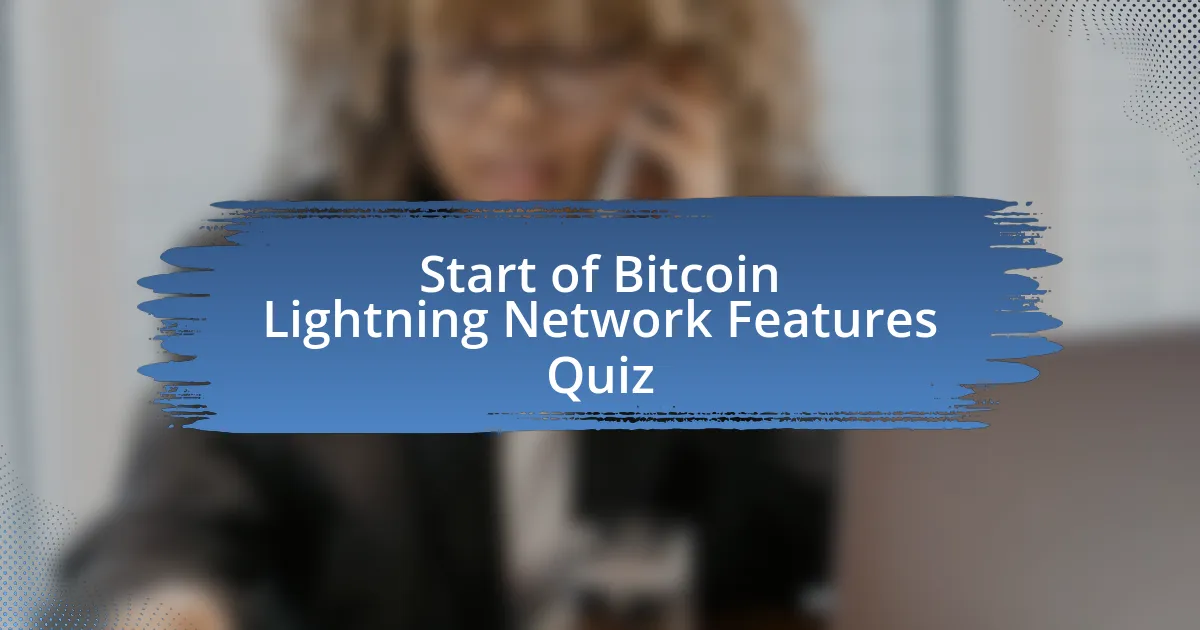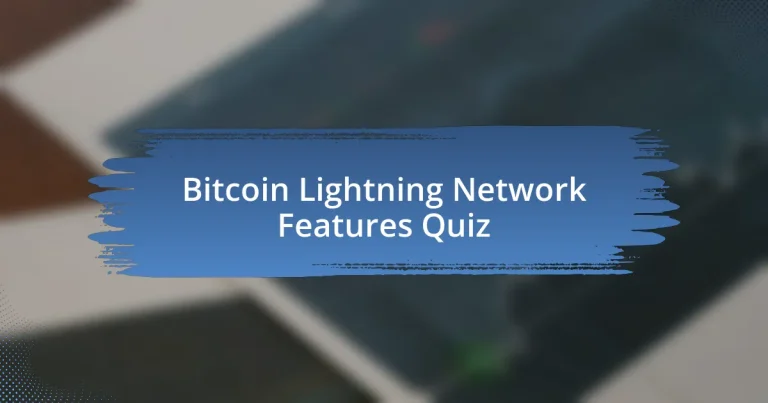
Start of Bitcoin Lightning Network Features Quiz
1. What is the primary aim of the Bitcoin Lightning Network?
- To facilitate faster and more cost-effective Bitcoin transactions.
- To enforce strict regulations on Bitcoin exchanges.
- To centralize Bitcoin mining operations globally.
- To increase the supply of Bitcoin available in the market.
2. How does the Lightning Network achieve faster transactions?
- By reducing transaction fees on a centralized server.
- By creating off-chain payment channels between parties.
- By storing all transactions directly on the blockchain.
- By requiring multiple confirmations from network miners.
3. What happens to transactions within a Lightning Network channel?
- They are conducted off-chain, meaning they are not recorded on the Bitcoin blockchain.
- They are immediately recorded on the Bitcoin blockchain.
- They are stored permanently on users` devices.
- They are held in a separate Lightning Network blockchain.
4. What transactions are recorded on the blockchain in the Lightning Network?
- All transactions between users in real time.
- Only the payments made inside the network.
- Regular transactions conducted within the channel only.
- The initial creation of the channel and the final settlement.
5. How does the Lightning Network allow for transactions between parties without a direct channel?
- By making all transactions public on the blockchain.
- By utilizing end-to-end encryption for all payments.
- By routing the payment through interconnected channels.
- By requiring a central authority to manage the transactions.
6. What is the throughput of the Bitcoin Layer-2 Lightning Network compared to the Bitcoin network?
- The Bitcoin Layer-2 Lightning Network has a throughput as high as 1 million TPS.
- The Bitcoin Layer-2 Lightning Network has a throughput of around 100 TPS.
- The Bitcoin Layer-2 Lightning Network has no throughput as it operates offline.
- The Bitcoin Layer-2 Lightning Network has a throughput similar to the Bitcoin network at 7-10 TPS.
7. What is a proposed implementation of Hashed Timelock Contracts (HTLCs) in the Lightning Network?
- Static transaction routes.
- Bi-directional payment channels.
- Fixed payment segments.
- Single-direction payment lanes.
8. What allows payments to be securely routed across multiple peer-to-peer payment channels in the Lightning Network?
- Hashed Timelock Contracts (HTLCs)
- Payment Processors
- Smart Contracts
- Transaction Fees
9. What happens to payments within an established channel in the Lightning Network?
- Payments within an established channel can be made almost as fast as data can travel over the Internet between the two peers.
- Payments are recorded directly on the Bitcoin blockchain immediately.
- Payments must be verified by a third party before completion.
- Payments take hours to process due to blockchain confirmation times.
10. Does the Lightning Network require third-party trust for transactions?
- Yes, third-party intermediaries are needed for every transaction.
- No, it relies solely on external platforms for all transfers.
- Yes, transactions have to go through multiple banks for verification.
- No, the two peers in a channel pay each other directly using regular Bitcoin transactions.
11. What transactions need to be committed to the blockchain in the Lightning Network?
- Channel open transactions, channel close transactions, and (hopefully infrequent) anti-fraud respends.
- Only small micropayments between peers.
- Direct trades between different cryptocurrencies only.
- Only the initial funding transaction for opening the channel.
12. Can channels in the Lightning Network stay open indefinitely?
- No, channels must close within a month.
- No, they can only stay open for a week.
- Yes, but only for a few hours.
- Yes, channels can stay open indefinitely.
13. What is the Lightning Network in relation to the Bitcoin protocol?
- It is a type of wallet specifically for storing Bitcoin.
- It is a method for tracking Bitcoin prices in real-time.
- It is a scaling solution built on top of the Bitcoin protocol.
- It is a new cryptocurrency separate from Bitcoin.
14. What does the Lightning Network facilitate for users?
- Large, slow transactions between banks.
- Single, high-value transactions that require lengthy approvals.
- Smaller, near-instant payments between users at very low cost.
- Complex investment portfolios managed by brokers.
15. How does Alice open a payment channel with Bob in the Lightning Network?
- Alice sends a direct payment in Bitcoin to Bob`s wallet address.
- Alice trades physical cash with Bob to establish the channel.
- Alice makes an on-chain ‘funding transaction’ which dictates how much value Alice can transfer using Lightning.
- Alice creates a new Bitcoin wallet and shares it with Bob.
16. What happens to the funding transaction after it is confirmed on the base layer?
- Alice must wait for a confirmation on every transaction before proceeding.
- The funding transaction is converted into a stablecoin for faster processing.
- The funding transaction is deleted from the blockchain immediately.
- Alice is free to transact with Bob over Lightning as many times as she likes until one or both of them decide they want to close the channel.
17. What updates the current state of the channel in the Lightning Network?
- The network has to be reset to update the channel state.
- The Bitcoin price must change to update the channel.
- Only miners can update the channel state.
- Each lightning transaction updates the current state of the channel.
18. What happens when a channel is closed in the Lightning Network?
- All funds are lost, and neither party receives anything back.
- The channel status is reset and can be reopened at any time.
- The most recent channel state is broadcast to the Bitcoin network, and parties receive their balances.
- The channel is permanently deleted, and no transactions can be recovered.
19. Does the Lightning Network have its own blockchain?
- No, the Lightning Network is a network of payment channels all interlinked together.
- Yes, the Lightning Network has its own independent blockchain.
- Yes, it operates on a separate blockchain.
- Yes, it functions with multiple blockchains for transactions.
20. How does the Lightning Network ensure security?
- Security is ensured by requiring all payments to be processed on the Bitcoin blockchain.
- Security is achieved through lengthy delays for transaction confirmations.
- Security is enforced by blockchain smart-contracts without creating an on-blockchain transaction for individual payments.
- Security is guaranteed by implementing a central authority to manage transactions.
21. What is the payment speed measured in the Lightning Network?
- Payment speed is measured in minutes to hours.
- Payment speed is measured in hours to days.
- Payment speed is measured in milliseconds to seconds.
- Payment speed is measured in seconds to minutes.
22. What is the scalability of the Lightning Network?
- The Lightning Network is capable of millions to billions of transactions per second across the network.
- The Lightning Network can process only one transaction per second.
- The Lightning Network is limited to a few thousand transactions per second.
- The Lightning Network cannot handle any transactions at all.
23. What is the cost of transactions in the Lightning Network?
- Transactions are exceptionally low-cost because they are transacted and settled off-blockchain.
- Transactions incur a standard Bitcoin fee for every transfer.
- Transactions are free but take an extended time to process.
- Transactions require a high fee due to network congestion.
24. What is the purpose of cross-chain atomic swaps in the Lightning Network?
- Cross-chain atomic swaps allow for transactions across blockchains without trust in third-party custodians.
- Cross-chain atomic swaps increase Bitcoin transaction fees significantly across networks.
- Cross-chain atomic swaps enable free trading of non-blockchain assets across different platforms.
- Cross-chain atomic swaps allow for faster Bitcoin mining operations between networks.
25. How do participants create a ledger entry on the blockchain in the Lightning Network?
- Participants create a ledger entry through a monthly bank statement.
- Participants create a ledger entry by sending a transaction to a centralized server.
- Participants create a ledger entry which requires both participants to sign off on any spending of funds.
- Participants create a ledger entry by manually writing it in a shared document.
26. What happens to the ledger entry when it is closed?
- The most recent version of the ledger entry is broadcast to the blockchain, and both parties receive their relevant balance back to their wallet.
- The ledger entry is deleted from the blockchain entirely with no record.
- The ledger entry remains unchanged and is stored indefinitely.
- The ledger entry is sent to a separate server for future reference.
27. What is the role of nodes in the Lightning Network?
- Nodes are only responsible for mining new bitcoins in the network.
- Nodes exclusively store Bitcoin wallets and funds for users.
- Nodes are devices that record transactions on a separate blockchain.
- Nodes are computers that run the Bitcoin software and manage the network of payment channels.
28. What is the role of smart-contract scripting in the Lightning Network?
- Smart-contract scripting allows for unlimited cryptocurrency mining on the network.
- Smart-contract scripting facilitates complex trading instructions in centralized exchanges.
- Smart-contract scripting challenges the validity of blockchain transactions entirely.
- Smart-contract scripting enforces the atomicity of transactions and ensures that only the most recent version of the ledger entry is valid.
29. What is the benefit of using real Bitcoin/blockchain transactions in the Lightning Network?
- It creates a secure network of participants that can transact at high volume and high speed.
- It allows for transactions to be anonymous and untraceable.
- It makes all transactions irreversible and permanent.
- It completely eliminates all transaction fees for users.
30. How does the Lightning Network solve Bitcoin’s scalability problem?
- The Lightning Network solves Bitcoin’s scalability problem by handling billions of transactions a second compared to twelve per second for Bitcoin.
- It restricts Bitcoin transactions to a single channel only.
- It eliminates the need for cryptocurrency exchanges entirely.
- It resolves scalability by increasing the block size limit on the Bitcoin blockchain.

Congratulations! You’ve Successfully Completed the Quiz
Well done on completing the quiz about the Bitcoin Lightning Network features! We hope you found it both enlightening and enjoyable. Engaging with these questions helps reinforce your understanding of how the Lightning Network operates and its benefits for Bitcoin transactions. You might have learned about speed, cost efficiency, and scalability, which are vital aspects of this innovative technology.
The more you explore the Lightning Network, the clearer it becomes how it is shaping the future of digital payments. Whether it was discovering how payments are routed or the significance of payment channels, every detail contributes to a broader understanding of cryptocurrency functionality. Engaging with this material can enhance your comprehension of its real-world applications.
We invite you to dive deeper into this topic by checking out our next section on the Bitcoin Lightning Network features. There, you will find comprehensive information that can broaden your knowledge and answer any lingering questions. Let’s continue this journey into the exciting world of Bitcoin together!

Bitcoin Lightning Network Features
Overview of the Bitcoin Lightning Network
The Bitcoin Lightning Network is a second-layer solution designed to facilitate faster and cheaper transactions within the Bitcoin ecosystem. It enables off-chain transactions, allowing users to transact without directly recording each transaction on the Bitcoin blockchain. This approach reduces congestion on the main blockchain and lowers transaction fees. The network operates through a system of payment channels, where users can send and receive payments instantly.
Scalability Features of the Lightning Network
The Lightning Network significantly enhances Bitcoin’s scalability. It allows millions of transactions to be processed off-chain simultaneously. By creating payment channels between users, it alleviates pressure on the Bitcoin blockchain during peak usage times. This mechanism enables the handling of a larger volume of transactions, thus improving the overall throughput of the Bitcoin network.
Instant Payment Capability
One of the key features of the Lightning Network is its ability to execute instant payments. When users transact within established payment channels, the transfers occur almost instantaneously. This feature is critical for applications requiring fast transaction confirmation, such as point-of-sale payments. It dramatically improves user experience by eliminating long wait times associated with traditional blockchain transactions.
Privacy Enhancements
The Lightning Network offers enhanced privacy for users. Transactions conducted through payment channels do not appear on the public blockchain, thus concealing transaction details from external observers. Only the opening and closing transactions of these channels are recorded. This feature protects user information and undermines attempts to trace individual transaction histories.
Multi-Party Payment Channels
The Lightning Network supports multi-party payment channels, allowing multiple users to join a single channel for transactions. This feature promotes efficiency by enabling group transactions without requiring each participant to establish separate channels. It minimizes the number of transactions recorded on the blockchain, further reducing fees and promoting faster interactions among users.
What are the key features of the Bitcoin Lightning Network?
The Bitcoin Lightning Network is a second-layer protocol that facilitates faster and cheaper transactions on the Bitcoin blockchain. Its key features include instant payments, lower transaction fees, Bitcoin micropayments, enhanced privacy, and scalability. Instant payments are achieved through off-chain transactions, which means users don’t have to wait for block confirmations. Lower transaction fees make it economically viable for small transactions. Micropayments enable users to transact amounts as low as a few cents. Enhanced privacy is provided since not all transactions are recorded on the blockchain, and scalability allows for thousands of transactions per second compared to Bitcoin’s capacity of about seven transactions per second.
How does the Lightning Network improve transaction speed?
The Lightning Network improves transaction speed by allowing transactions to occur off-chain rather than directly on the Bitcoin blockchain. This process involves opening payment channels between users, where multiple transactions can take place without needing each one to be confirmed by the blockchain. Once the transactions are completed, only the final state is recorded on the blockchain. This reduces the waiting time from minutes for confirmation on the blockchain to near-instantaneous transactions within the network.
Where can the Lightning Network be used?
The Lightning Network can be used in various platforms that support Bitcoin transactions, including wallets, exchanges, and merchant services. Many cryptocurrency wallets, like Blue Wallet and Phoenix, support Lightning transactions. Some e-commerce platforms have integrated Lightning payments to facilitate fast transactions for users, enhancing the overall shopping experience. Additionally, major exchanges, such as Bitfinex and Binance, have begun implementing the Lightning Network for quicker deposit and withdrawal options.
When was the Lightning Network first implemented?
The Lightning Network was first proposed in a research paper published in January 2016 by Joseph Poon and Thaddeus Dryja. The first implementation of the Lightning Network came with the launch of the Lightning Network Daemon (lnd) by Lightning Labs in 2018. This marked a significant step toward operationalizing the theoretical aspects of the network, allowing users to begin testing the second-layer solution.
Who developed the Lightning Network?
The Lightning Network was primarily developed by researchers Joseph Poon and Thaddeus Dryja. Their proposal laid the foundational ideas for the protocol. Following this, multiple organizations contributed to its development, including Lightning Labs, Blockstream, and ACINQ. Each of these companies has played a vital role in advancing the implementation and functionality of the network, helping it evolve into a working solution for fast Bitcoin payments.


